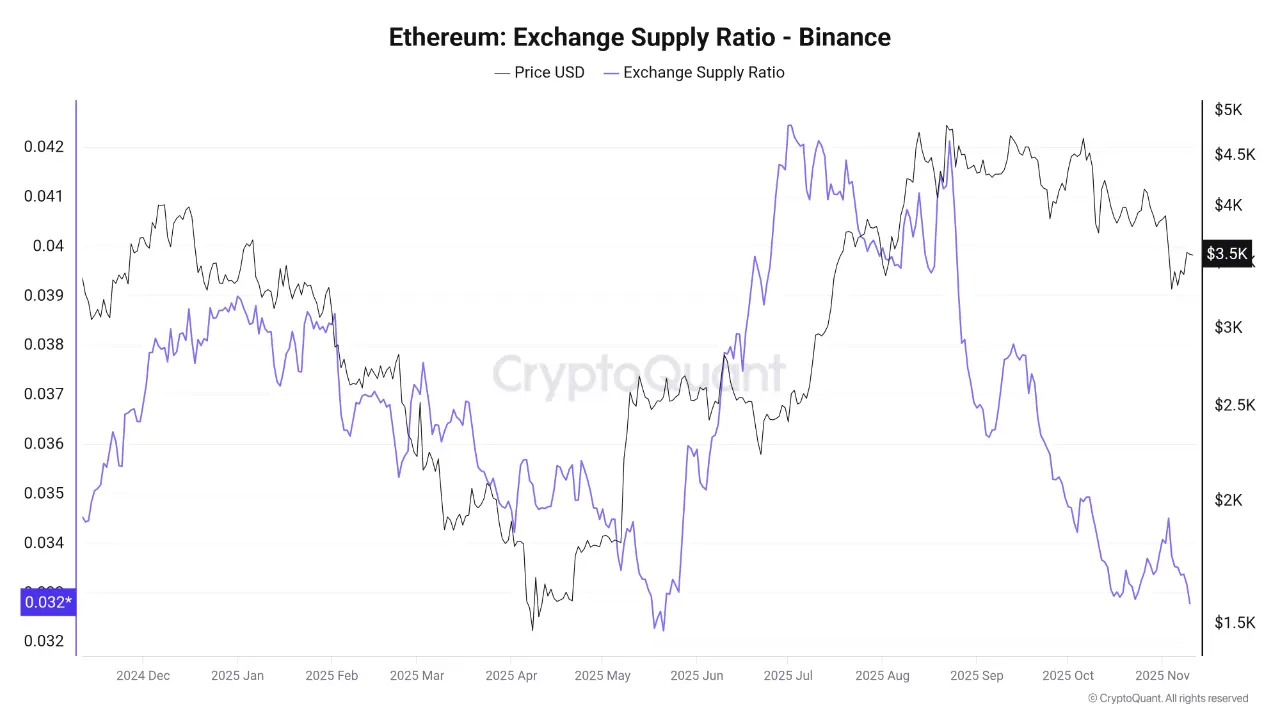
- Ethereum fails to break above the 200-day EMA amid short-term bearish market dynamics.
- The balance of Ethereum on Binance exchange falls to its lowest level since May, hinting at a potential bullish turnaround.
- Ethereum derivatives market has been muted since mid-October as risk-off sentiment persists among retail investors.
Ethereum (ETH) falls for the second consecutive day, trading below $3,500 at the time of writing on Tuesday as bearish waves trigger a cascade of losses in the broader cryptocurrency market.
The largest smart contracts token failed to sustain recovery toward $3,700 on Monday primarily due to potential profit-taking, risk-off sentiment, and sticky macroeconomic uncertainty.
Institutional demand for Ethereum Exchange Traded Funds (ETFs) is also on the back foot. As reported, all nine US-listed ETFs recorded zero inflows on Monday, emphasising the prevailing risk-off sentiment.
Ethereum supply on exchanges narrows
The balance of Ethereum on Binance, the largest crypto trading platform by volume, has been steadily declining since peaking in June and July, according to CryptoQuant. According to the chart below, the ETH supply ratio remains at 0.0327, the lowest level since May.
"This continuous decrease in the available Ethereum supply on exchanges typically indicates a movement of coins into cold or private wallets — a behavior considered bullish in the medium to long term, as a reduction in the supply available for sale alleviates market pressure," Arab Chain stated via CryptoQuant.
If the decline in supply persists, it could lead to a liquidity crunch for Ethereum available on the open market. This imbalance could trigger an upswing in Ethereum's price, bolstered by improving risk appetite among retail investors.
Still, investors should be cautiously optimistic, as the exchange supply crunch may have little effect on the price in the near term. Ethereum may enter into choppy sideways action or even decline in the short term. Navigating this transition phase is critical for both short-term and long-term investors.

Retail demand for Ethereum has also not picked up following the October 10 deleveraging event, which saw over $19 billion in crypto assets liquidated in a single day.
The ETH futures Open Interest (OI) averages $41 billion at the time of writing, down from $46 billion on November 1. OI has to steadily rise to support Ethereum's recovery in the short to medium term.

Technical outlook: Ethereum gives back gains amid bearish signals
Ethereum is trading below $3,500 and key moving averages, including the 200-day Exponential Moving Average (EMA) at $3,594, the 100-day EMA at $3,878 and the 50-day EMA at $3,888 on the daily chart.
The smart contracts token is largely weighed down by potential profit-taking and reduced risk-on sentiment following Monday's upswing to highs around $3,656.
The Relative Strength Index (RSI) at 41 points to a further move toward oversold conditions, signaling that bullish momentum is fading. Ethereum may extend its down leg toward the next support at $3,350, which was last tested on Sunday.

Conversely, the MACD is poised to flash a buy signal on the same chart if the blue line crosses and settles above the red line and the indicator generally rises. A buy signal would encourage bulls to seek exposure, further tailwinding a breakout above the 200-day EMA at $3,695.
Ethereum FAQs
Ethereum is a decentralized open-source blockchain with smart contracts functionality. Its native currency Ether (ETH), is the second-largest cryptocurrency and number one altcoin by market capitalization. The Ethereum network is tailored for building crypto solutions like decentralized finance (DeFi), GameFi, non-fungible tokens (NFTs), decentralized autonomous organizations (DAOs), etc.
Ethereum is a public decentralized blockchain technology, where developers can build and deploy applications that function without the need for a central authority. To make this easier, the network leverages the Solidity programming language and Ethereum virtual machine which helps developers create and launch applications with smart contract functionality.
Smart contracts are publicly verifiable codes that automates agreements between two or more parties. Basically, these codes self-execute encoded actions when predetermined conditions are met.
Staking is a process of earning yield on your idle crypto assets by locking them in a crypto protocol for a specified duration as a means of contributing to its security. Ethereum transitioned from a Proof-of-Work (PoW) to a Proof-of-Stake (PoS) consensus mechanism on September 15, 2022, in an event christened “The Merge.” The Merge was a key part of Ethereum's roadmap to achieve high-level scalability, decentralization and security while remaining sustainable. Unlike PoW, which requires the use of expensive hardware, PoS reduces the barrier of entry for validators by leveraging the use of crypto tokens as the core foundation of its consensus process.
Gas is the unit for measuring transaction fees that users pay for conducting transactions on Ethereum. During periods of network congestion, gas can be extremely high, causing validators to prioritize transactions based on their fees.








